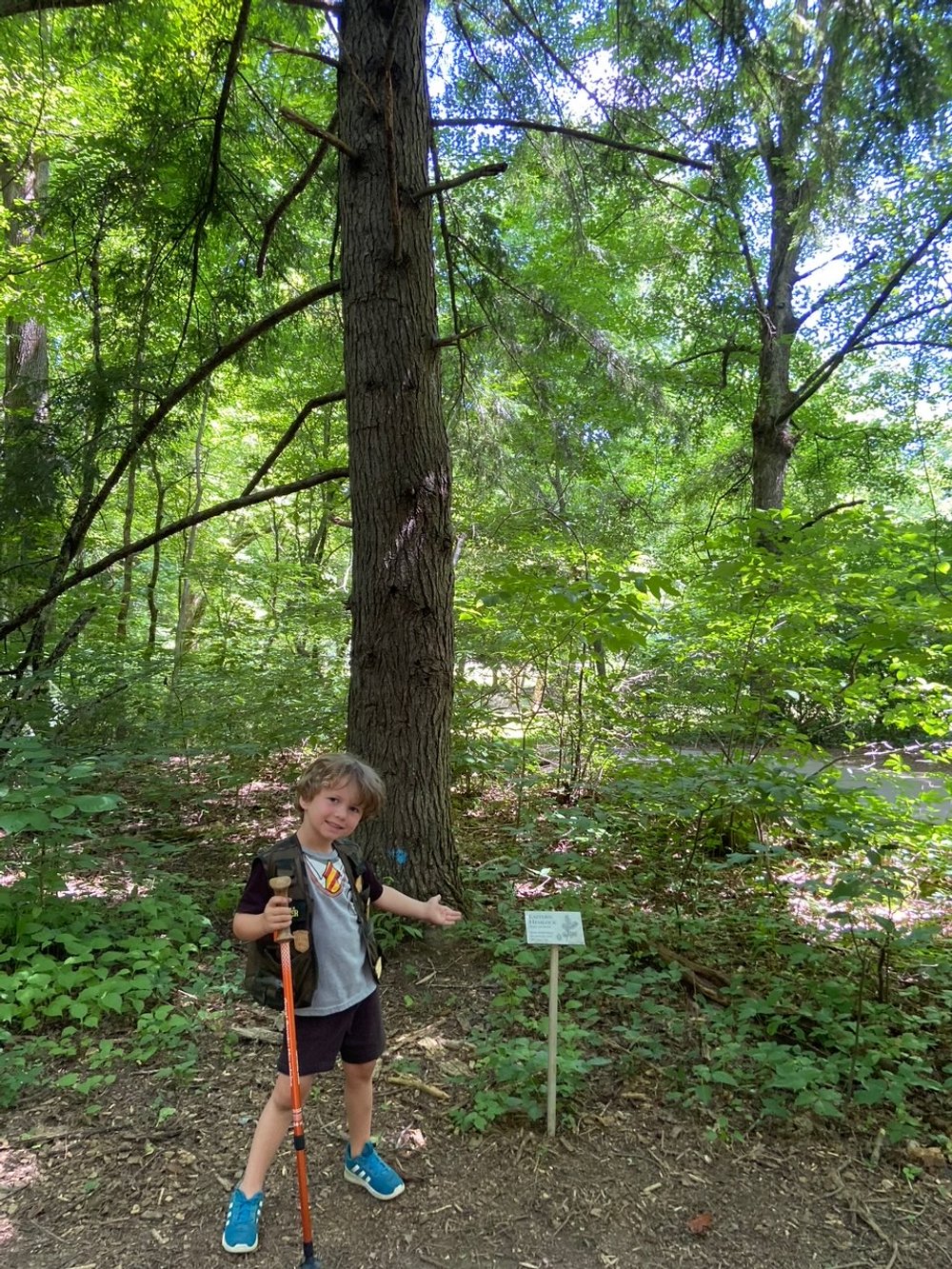Cataract Falls Hike in Gatlinburg, TN: A Guide
Let’s head out on the Cataract Falls hike in Great Smoky Mountains National Park near Gatlinburg, Tennessee!
This easy hike is great for all ages and ability level, and has a pretty little waterfall at the endpoint.
Plus, it’s proximity to the Sugarlands Visitors Center in Great Smoky Mountains National Park means you’re never far from amenities.
Whether you’re doing a day trip into the national park from Pigeon Forge or Gatlinburg, or you’re planning the hike as part of a longer park experience, you’ll find everything you need to know about Cataract Falls below.
I’ve included information on parking, what to bring, and what you’ll see at each step along the way.
This post contains affiliates. If you purchase through the links below, I will receive a commission at no charge to you.
Cataract Falls Hike: Know Before You Go
Where is the Cataract Falls Hike?
The Cataract Falls Trail begins behind the Sugarlands Visitors Center, which is the closest visitors center to both Gatlinburg and Pigeon Forge, Tennessee. These towns have so much to do and are a great place to base yourself while visiting the national park. They both made my list of the best towns near Great Smoky Mountains National Park!
Cataract Falls is located on the northern side of the Great Smoky Mountains National Park.
The Cataract Falls hike is just one section of 2 longer trails: the Fighting Creek Nature Trail and Cove Mountain Trail.
Fighting Creek Nature Trail begins behind the Sugarlands Visitors Center, and meanders west. The Fighting Creek Nature Trail branches off, and you’ll leave that trail to pick up the Cove Mountain Trail about halfway through the hike to Cataract Falls.
It’s all well marked, and it’s a popular hike, so there are likely others to ask on the trail if you get confused.
Directions to Cataract Falls Trailhead
There are 2 points of entry onto a hiking trails that lead to Cataract Falls. You can start further away at the Fighting Creek Nature Trail near Sugarlands Visitors Center, or you can begin at the Cove Mountain Trail trailhead near the Sugarlands Headquarters parking lot.
Starting at the Fighting Creek Nature Trail adds about 0.25 miles to the hike each way, making the entire hike from the Sugarlands Visitors Center to Cataract Falls about 1 mile total roundtrip hike.
You’ll find the start of the Fighting Creek Nature Trail between the main building at Sugarlands Visitors Center and the restroom building.
Otherwise, start at the Cove Mountain Trail trailhead for a brisk half-mile hike round trip.
To access the Cove Mountain Trail, walk across the small bridge on Sugarlands Residence Road behind the park headquarters. The trailhead will be to your right on the far side of the bridge.
Parking at Cataract Falls
The closest you can park to access any portion of the trail to Cataract Falls is in the Sugarlands Headquarters parking lots A, B, and C. Parking here will allow you to skip the first section of the trail (the part that runs along Fighting Creek Nature Trail) and pick it up at the Cove Mountain Trail trailhead.
However, if you’d like to extend your hike on a beautiful trail, opt to park at the Sugarlands Visitors Center, adding in the section of Fighting Creek Nature Trail that connects the Sugarlands Visitors Center with the Cove Mountain Trail.
Is Cataract Falls Good for Kids?
Yes, the Cataract Falls hike is great for kids, thanks to its easy trail conditions and convenient trailhead near park amenities.
The trail is largely flat and it’s well sign posted throughout. While the trail is made of packed dirt and there are roots along the way, you won’t have to worry about any serious elevation changes or rock scrambles.
It’s not quite stroller friendly thanks to the roots, but we’ve seen families pulling young kids in all-terrain collapsible wagons without too much trouble.
I’d recommend foregoing the wheels all together and making use of babywearing (the mesh Tula carrier was a favorite of ours when we had little tiny hikers!). It’s a short trail, so you could even let your toddlers and preschoolers walk on their own for the majority of the way.
There’s plenty of visual interest to keep even little hikers engaged from a wide variety of plants to Fighting Creek, which you’ll follow for much of the way.
For even more engagement, get a Junior Ranger booklet from the Sugarlands Visitors Center before you head out. This booklet has projects that work great for this trail, including picking up a bag of trash and completing a photo scavenger hunt of items like a river, specific trees, and a park sign.
Overall, though, it’s much more beginner-friendly than some of the short hikes in the park like Clingman’s Dome. [See my complete guide to the Clingman’s Dome hike here!]
Do I Need a Permit or Reservation for Cataract Falls?
No, Cataract Falls does not require a permit or reservation to hike the trail.
Great Smoky Mountains National Park in general is free to access and requires no reservation to enter (unlike other national parks like Arches National Park in Moab, Utah, and Glacier National Park in Hungry Horse, Montana).
How busy is this trail?
This area was one of the busiest on the trail—and it still wasn’t too bad.
At peak times, you’ll have more people on this last section of trail than you did on the first part.
I’d recommend going early in the morning during the week if you’d like a quieter hike.
That being said, we’ve done this hike in the middle of the day during a summer weekend (a peak time for the park!) and, while the trail had other hikers, it wasn’t so crowded that we were bumping into people.
In fact, we encountered more hikers in a shorter amount of time at the Inspiration Point and Hidden Falls trail in Grand Teton National Park mid-week after Labor Day than we did anywhere in Great Smoky Mountains National Park during our summer visits.
The Great Smoky Mountains National Park is bigger than the Grand Tetons, so I imagine that’s what helps with overall congestion on the trails.
Cataract Falls Hike: Step by Step
The Camping Kiddos at the start of the Fighting Creek Nature Trail
NOTE: This trail guide covers the longer approach to Cataract Falls, beginning at the Sugarlands Visitors Center. If you plan to begin the trail halfway through at the Cove Mountain Trailhead, skip below to the bolded subheading.
Start off at the Sugarlands Visitors Center (and grab your Junior Ranger booklet if you haven’t already as you’ll have multiple opportunities to add to it on this hike.)
If you’re not familiar with the Junior Ranger program, read through my comprehensive guide to the national parks for beginners, which will answer your questions on this topic and many more.
If you’re looking at the front of the visitors center, the large building to the left will be the restrooms/comfort station.
There will be a paved, concrete walkway between the 2 buildings, and this is where you’ll start out.
Follow this trail behind the buildings, and it will curve to the left, quickly becoming shadier as you head into the forest.
This is where the Fighting Creek Nature Trail begins in earnest, and you’ll see dozens of types of trees along the wide, well manicured path.
About 500 feet onto the trail, you’ll cross a small footbridge over Fighting Creek and the trail will fork soon afterwards.
A peaceful stream on the trail with park buildings in background
Take the right hand side of this fork, which will take you north towards the park headquarters. You’ll follow along the Ash Hopper Branch of Fighting Creek, keeping it within viewing distance nearly this entire stretch.
You should be able to see the backs of the park headquarters across the stream. Note: the park headquarters and the Sugarlands Visitors Center are 2 separate areas, though they are quite close as the crow flies.
The trail will go underneath a stone bridge. On the top of this bridge is Sugarlands Residence Road and this is where you’ll intersect with the trailhead for Cove Mountain Trail.
From here to the falls is about a quarter-mile one way, so you’re practically there! The trail will curve away from the creek as you get closer to the falls, but you’ll still be able to hear it throughout the rest of the trail.
You’ll quickly see Cataract Falls nestled among the trees of the forest. It’s not a big cascade—only about 25 feet—but it is pretty.
There’s water here year-round, so you’re all but guaranteed to see a waterfall of some ilk even in drier seasons. The best time to go is a day or so after a big rainfall, when the waterfall bulks up a bit.
Upclose at the falls
There isn’t much of a place to splash around, and the water at the base of the falls is too shallow to be a swimming hole. Still, you can find a small area to cool off your feet before you head back.
From here, you simply return on the trail the way you came.
You’ll see that the Cove Mountain Trail does continue on past the falls and over the Cataract Branch, but that’s a much longer hike that’s not idea for the youngest hikers.
From Cataract Falls, the end of Cove Mountain Trail is another 3.1 miles (one way). You will get to see another falls, Laurel Falls, and an old fire tower if you keep going, which might be interesting for older and more experienced hikers.
Overall, the Cataract Falls trail is an excellent one for the entire family with a great pay-off. It’s a great way to start off a week in Great Smoky Mountains National Park, but it’s an equally great day trip from Gatlinburg.
What to Bring to Cataract Falls Trail
Trash bag
One thing that we loved about the Junior Ranger program at Great Smoky Mountains National Park is that it encouraged our kids to help keep the park clean by filling up a trash bag.
I thought we’d have a tough time finding enough trash to do so, but it was (unfortunately) pretty easy.
The Camping Kiddos found a park newspaper as one of the Junior Ranger scavenger hunt items!
Given that this park sees such high attendance numbers—and most are within the 3 months of summer each year—it’s a sad fact that the park needs such measures to help with the amount of litter people leave behind.
Whether you’re doing the Junior Ranger program or not, bring a trash bag to help out. You’ll find receptacles to place your filled bags near the front of Sugarlands Visitors Center.
Junior Ranger booklet
The activities in your booklet range from plant identification to a nature-based scavenger hunt, and there are opportunities to do all of those on this trail.
Put your booklet and provided pencil in your day pack for easy access.
These are just a few dollars, and you can pick them up at the Sugarlands Visitors Center information desk. (NOTE: Usually the Junior Ranger booklets are free, but a handful of places charge for them to reduce unnecessary waste.)
Good hiking shoes
While the trail is short, there are sections with small rocks and roots that can hurt your feet if you’re wearing regular tennis shoes or flip flops.
You don’t want to slow down your time in the Great Smoky Mountains with sore feet, so do yourself a favor and invest in some high quality shoes that are made for the trail.
For this hike, I wore my Altra TIMP 4 trail running shoe, but I’ve also worn my Keen Newport H2 hiking sandals to the Smokies on our many hikes in this area.
Get more hiking and gear guides here:








